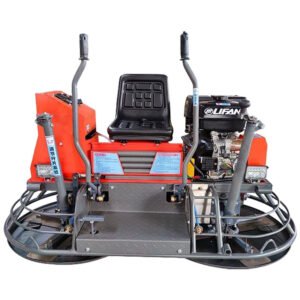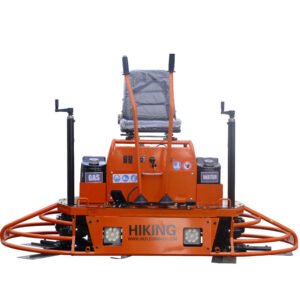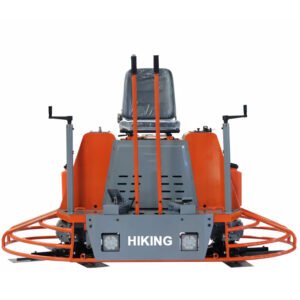Are you a concrete contractor looking to learn more about Power Floats? This guide will show you how to effectively use this powerful tool, optimize your construction processes, choose the right model, and understand how it differs from polishing methods. We’ll explore Power Float’s applications in industrial, commercial, and outdoor projects to help you improve both the flatness and aesthetic appeal of concrete.
This article highlights the significance of Power Floats in enhancing construction efficiency and reducing manual errors, ensuring that every worker can benefit from its advantages. If you want to elevate the quality of your concrete work, keep reading!
What is Power Float?
A Power Float is a specialized tool used in concrete construction to finish and smooth surfaces after pouring. It features a high-speed rotating blade—typically up to 150 RPM—with an adjustable angle (generally between 5 to 10 degrees), allowing the operator to control the pressure applied to the concrete. This tool effectively reduces surface irregularities, enhancing the appearance and durability of the floor.
When Should You Use Power Float?
Power Floats are versatile tools suitable for various applications, particularly in industrial and commercial settings. In large warehouses and factories, they create smooth concrete floors that enhance safety and efficiency by preventing slippage. Similarly, retail spaces and offices benefit from visually appealing surfaces that are easy to maintain, with Power Floats helping achieve the desired gloss and finish.
Additionally, Power Floats are effective for outdoor surfaces such as sidewalks and parking lots. They contribute to the durability and longevity of concrete, ensuring that these areas remain both functional and aesthetically pleasing over time.
Types of Power Float
Power Floats are mainly categorized into two types:
Hand-held Power Trowel: This compact tool is ideal for smaller sites or areas with complex shapes. It’s easy to manoeuvre, enabling effective smoothing in various locations.
Ride-on Trowel: Designed for larger areas, this model allows the operator to sit, reducing labour intensity. Ride-on trowels are typically more efficient and can cover extensive ground quickly.
Power Sources for Power Float
Power Floats offer several power options to suit different needs: gasoline-powered models are ideal for outdoor use since they don’t require an electrical supply. At the same time, electric drive versions provide a low-noise, environmentally friendly choice for indoor applications. Additionally, battery-powered models offer high portability, making them perfect for job sites where using electric cords is impractical.
Difference Between Power Float and Polished Concrete
It’s essential to differentiate between power floating and polished concrete:
Power Float: This process is performed before the concrete is fully cured and is primarily aimed at achieving an initial smooth surface.
Polished Concrete: This involves deeper grinding after the concrete has dried completely, using specialized equipment to create a mirror-like finish focused on aesthetic appeal and durability.
Do You Need a Power Float?
In the European market, Power Float prices vary based on brand, functionality, and type. Generally:
Rental Prices: Daily rentals for walk-behind trowels range from €50 to €100, while ride-on trowels cost between €150 and €300.
Sales Prices: Walk-behind trowels usually cost between €800 and €2,000, while ride-on models can exceed €4,000.
Choosing the right equipment is crucial, as it impacts project quality and efficiency. Therefore, opt for a reputable brand and a model that fits your needs.
Hiking machinery is also a professional power float supplier, providing European customers with cost-effective products. Welcome to purchase Hiking power float!
-
Concrete Power Trowel
W60 Mini Power Trowel
€2,800.00Original price was: €2,800.00.€1,780.00Current price is: €1,780.00. -
Concrete Power Trowel
GN100 Concrete Power Trowel
€3,500.00Original price was: €3,500.00.€2,780.00Current price is: €2,780.00.
Lorem ipsum dolor sit amet, consectetur adipiscing elit. Ut elit tellus, luctus nec ullamcorper mattis, pulvinar dapibus leo.
Why Use a Power Float?
Using a Power Float significantly improves the flatness and smoothness of concrete surfaces while also reducing labour costs and minimizing errors. One of the key benefits is their ability to enhance flatness and smoothness; Power Floats apply pressure evenly, resulting in a consistent and durable finish that is visually appealing.
Additionally, Power Floats improve efficiency by allowing for quicker coverage of larger areas compared to traditional manual methods. This efficiency leads to shorter project timelines and reduced costs, making them an advantageous choice for various construction projects.
Moreover, Power Floats help lower labour costs and errors by minimizing the skill level required for workers. Even those with less experience can achieve consistent results, which reduces the need for extensive training and lowers the risk of rework. Their versatility also allows them to perform well in various environments, including indoor and outdoor settings and humid or less-than-ideal weather conditions.
When to Use a Power Float
Power Floats are most effective on moderately wet concrete over large areas. Here are some guidelines:
After the Initial Setting of Concrete: Use a Power Float when the concrete has partially set, leaving a footprint of about 3-4 mm on the surface. This allows the tool to achieve optimal levelling results.
Maintaining the Right Moisture Level: Ensure the concrete surface remains at an ideal moisture level—neither too dry nor too wet. Using a Power Float on overly dry concrete can cause cracking, while excess moisture may hinder operation.
Applicability Over Large Areas: In expansive projects, Power Floats greatly enhance efficiency, completing work faster than manual tools.
Conclusion
This article provided a comprehensive overview of how and when to use a Power Float, which models to consider, and how they differ from traditional polishing methods. Power Floats can significantly improve the flatness and visual appeal of concrete, making them suitable for industrial, commercial, and outdoor applications. By effectively reducing labour costs and minimizing errors, Power Floats enable contractors to complete tasks more efficiently.
If you found this article helpful, please share your thoughts in the comments and consider passing it on to friends so more people can discover the benefits of using a Power Float!







